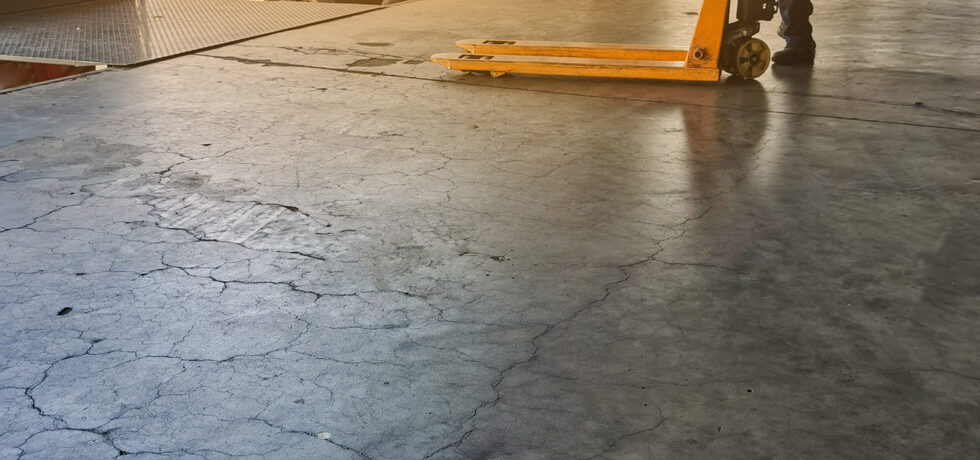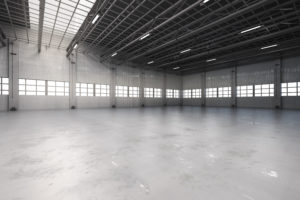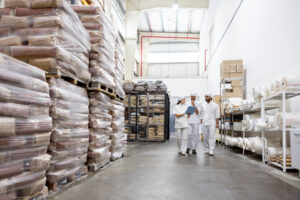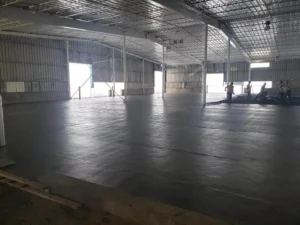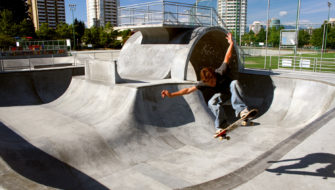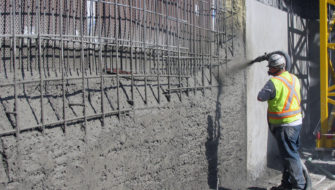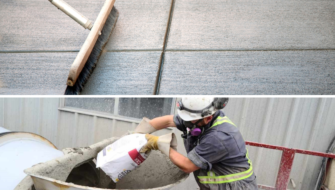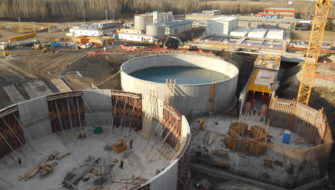Concrete’s ability to remain durable in harsh environments is critical to ensuring its longevity and usefulness over the lifetime of the structure.
During a recent webinar, concrete experts Adam Creelman and Brock Jensen discussed essential strategies for enhancing the longevity and performance of concrete surfaces.
In this blog post, we’ll explore some of the topics discussed in the webinar, including the reasons concrete durability is so important and the pros and cons of some of traditional and modern solutions for abrasion and erosion resistance.
1. Understanding the Importance of Concrete Protection
The primary goal of concrete durability is to resist abrasion and erosion from wear and environmental factors and dextend the concrete’s overall service life. By specifying and selecting appropriate concrete admixtures and treatments, architects, engineers, and contractors can enhance the resistance of their clients’ concrete to physical and chemical stresses, and improve its impermeability — and its ability to withstand harsh environments and wear and tear.
Ultimately the right durability solutions will ensure concrete is equipped to handle the demands of any use case, resulting in the following benefits:
Extended Lifespan: Durable concrete reduces the need for frequent repairs, minimizing maintenance costs and enhancing the overall lifecycle of the structure.
Cost Efficiency: Lower maintenance and repair costs over time result in significant savings and lower overall cost of ownership of the structure. Additionally, delayed replacement means reduced expenditure on new materials and labor.
Safety and Functionality: Durable concrete surfaces ensure better functionality and safety, particularly in high-traffic or industrial areas where surface integrity is critical.
Carbon Savings: Minimizing replacement and repair requirements effectively reduces the need for more carbon-intensive cement usage, effectively lowering the structure’s embodied carbon footprint over its lifetime.
2. Exploring Methods to Enhance Concrete Durability
Various methods exist to protect concrete surfaces, each with distinct advantages and considerations.
Dry Shake Hardeners
Dry shake hardeners involve applying a blend of metallic or non-metallic aggregates to the surface of fresh concrete. They use bleed water to create a dense, durable surface to the top of the concrete.
Dry shakes are limited in their application as they are incompatible with air entrainment and many supplementary cementitious materials (SCMs). Additionally they cannot be used on formed surfaces. Modern concrete mixes with low water content can also make it difficult to achieve the necessary bleed water for proper application.
On flat surfaces, dry shakes typically provide decent initial abrasion resistance if applied correctly. The complexity involved in their application, however, often negatively impacts their overall performance. The primary challenges revolve around ensuring an even and consistent distribution of the material and effectively handling surface moisture both before and during the application.
Dry shakes are applied after the concrete is poured and require additional expert labor and equipment for the application, which often creates schedule delays and incurs extra costs. In addition, most dry shakes pose significant risks on site. The silica dust generated during application is a recognized health risk and has broader environmental implications. For this reason, workers applying the shake and workers in the vicinity of the application area are required by OSHA to adhere to multiple safety precautions.
| Pros | Cons |
|
|
Chemical Hardeners or Liquid Densifiers
Like dry shakes, densifiers are applied to the concrete surface and react chemically to fill concrete pores with silicates, enhancing hardness and reducing permeability. They can be effective in increasing surface durability, particularly against surface wear and abrasion, but the benefits are primarily limited to the surface, offering little to no improvement to the concrete’s internal structure.
Despite being cost-effective and offering some superficial benefits, liquid densifiers (sometimes referred to as hardeners) possess several technical shortcomings. Like dry shakes, they are applied post-pour and require skilled laborers for application. Improper application can result in undesirable surface deposits, affecting the appearance and potentially requiring mechanical abrasion for removal.
Liquid densifiers are well known to degrade over time. In the best case, they require frequent re-application, which isn’t just labor-intensive but also results in slab downtime and lost productivity. In the worst case, they result in the replacement of the entire slab due to abrasion and erosion that takes place once the wear layer delaminates.
| Pros | Cons |
|
|
Integral Hardeners
Integral hardeners are mixed directly into the concrete, uniformly enhancing the entire slab. This method offers long-lasting, abrasion and erosion-resistant concrete without the need for additional surface treatments.
Hard-Cem is one of the only integral hardeners on the market. It is a concrete admixture for abrasion and erosion resistance that — unlike dry shakes and liquid densifiers — is integrated directly into the concrete mix (via water soluble bags) to improve the durability, lifespan, and sustainability of concrete structures.
It uses a unique metal-mineral microstructure that delivers high-performance concrete with no additional floor treatments required. Hard-Cem significantly reduces replacement and repair requirements and more than doubles the concrete’s wear life, effectively lowering the structure’s embodied carbon footprint over its lifetime.
| Pros | Cons |
|
|
3. Considering Application Specifics
When choosing a method for enhancing concrete durability, it’s essential to consider the specific application and environmental factors that the concrete will face over its lifetime. Below are some examples where integral hardeners were the most effective solution:
High Traffic Area at Old Neighborhood Foods Facility Upgrade
For locations like warehouse floors, loading docks, and industrial aprons, integral hardeners are recommended due to their superior abrasion resistance.
Old Neighborhood Foods, a manufacturer of processed meat products in Lynn, Massachusetts, aimed to enhance the durability and longevity of its renovated facility’s industrial floor. They needed a concrete solution that would provide a robust, long-lasting working slab capable of supporting heavy equipment and traffic, including forklifts, pallet jacks, and trolleys.
Hard-Cem was selected as its integral nature meant that even if the surface were to experience superficial damage, Hard-Cem’s protection would extend throughout the depth of the concrete, maintaining its structural integrity.
The facility’s new concrete floor exhibited exceptional durability and resistance to the harsh conditions typical of food processing operations. The enhanced abrasion and chemical resistance of the floor meant that Old Neighborhood Foods could anticipate significantly lower maintenance costs and extended service life for their facility.
Moreover, the use of Hard-Cem contributed to a more hygienic processing environment by reducing the floor’s permeability, making it less susceptible to water penetration and contamination. This aspect was particularly crucial given the stringent cleanliness standards required in food processing.
Exterior-Like Surface at the Ice Arena in Regina, Saskatchewan
In environments exposed to freeze-thaw cycles, integral hardeners are preferable as they do not compromise air entrainment necessary for freeze-thaw resistance.
At the Ice Arena in Regina, Saskatchewanm the concrete slab was exposed to exterior-like conditions with freeze-thaw cycles and the melting ice. It also needed to withstand significant abrasion from ice skates and equipment.
45,000 kilograms of Hard-Cem added directly into the concrete mix to enhance the entire slab, ensuring consistent abrasion resistance and freeze-thaw durability, extending the service life and reducing maintenance requirements.
Exterior Apron in Bonnyville, Alberta
The exterior apron required a durable surface that could withstand heavy vehicle traffic and environmental exposure. The need for air entrainment to resist freeze-thaw damage posed a challenge for traditional surface-applied hardeners.
Hard-Cem was added to the concrete mix at the batch plant, ensuring thorough integration throughout the slab. The project successfully utilized Hard-Cem to achieve a hardened, durable surface that could withstand heavy use and environmental stresses. The integral hardener allowed for air entrainment without compromising surface hardness, providing a long-lasting solution.
For more details about ensuring durable concrete, watch our on-demand webinar Concrete Durability: 3 Things to Consider to Protect Concrete Surfaces from Wear and Tear, or contact us.

